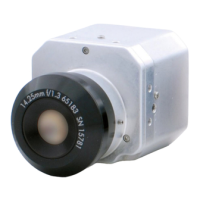26
Chapter 4
are typically captured afterward to reveal
heat dissipation characteristics.
In other applications of this sort, a good
image can be stored and compared to
the inspection image by using pixel-by-
pixel subtraction. Ideally, the resulting
image would be entirely black, indicating
no dierence and a good part. Areas
with excessive temperature dierences
indicate a bad part, making it very easy to
discern unwanted dierences.
There are many other applications
where the combination of non-contact
temperature measurements and imaging
at high frame rates is extremely valuable.
Some automated systems where IR
cameras are already being used include:
Automotive part production and •
assembly lines
Steel mill operations, such as slag •
monitoring and ladle inspection
Casting, soldering, and welding of •
metals and plastics
Food processing lines•
Product packaging•
Non-destructive testing, like sub-•
surface detection of voids in molded
parts
Electric utility equipment monitoring•
R&D, prototyping, and production in •
the electronics industry
An interesting automotive example is
monitoring the temperature distribution
of a pressure casting mold for a safety-
critical part (Figure 2). Prior to installation
of the IR machine vision system, the
manufacturer was doing 100% inspection
using an X-ray system to reveal
subsurface imperfections. It was not
practical to do this as an inline procedure,
so the X-rays were taken a few hours after
part production. If the X-rays showed a
signicant problem in parts coming from
a particular mold, this information was
relayed to the production area so that
mold temperatures could be adjusted.
This was a lengthy and costly process that
often resulted in high scrap rates. With
the IR camera system, the mold operator
can immediately check and adjust the
temperature distribution of the mold.
Figure 2. Pressure casting mold and its
temperature distribution – an IR camera
image is used by the operator to adjust the
mold temperatures as required to produce
good parts.
Enabling Technology
Data communications are the backbone
of modern industrial SCADA, PLC, HMI’s,
and Machine Vision systems. Ethernet has
become the de facto standard for such
systems. Considering this, the features of

